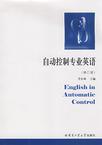自动控制专业英语
2003-6
哈尔滨工业大学出版社
李东林 编
313
本书以培养学生的专业英语阅读能力为主要目标,内容共分为三部分:第一部分为古典控制理论;第二部分为现代控制理论;第三部分为科技文献阅读。读者通过对前两部分的学习,不但可以熟悉自动控制常用专业词汇,而且也可对现代控制理论较为活跃的理论分支有一定了解;后一部分旨在为读者最终阅读专业文献铺设最后的桥梁。 本书可作为高等院校自动控制专业学生的英语阅读教材,也可作为自动控制类专业技术人员的学习、参考用书。
PART 1 1 Introduction and Linearized Dynamic Models 1.1 Introduction 1.2 Examples and Classifications of Control Systems 1.3 Open-Loop Control and Closed-Loop Control 1.4 Control System Analysis and Design 1.5 Linearized Dynamic Models 1.6 Laplace Transforms 1.7 Transfer Functions and System Response 1.8 Block Diagram Reduction 1.9 Conclusion 2 Transfer Function Models of Physical Systems 2.1 Introduction 2.2 Mechanical Systems 2.3 Electrical Systems: Circuits 2.4 Electromeehanical Systems: Transfer Functions of Motors and Generators 2.5 Thermal Systems 2.6 Fluid Systems 2.7 Fluid Power Control Elements 2.8 Conclusion 3 Transient Performance and the S-Plane 3.1 Introduction 3.2 The S-Plane,Pole-Zero Patterns,and Residue Calculation 3.3 Transient Response, Including Repeated and Complex Poles 3.4 Simple Lag: First-Order Systems 3.5 Quadratic Lag:Second-Order Systems 3.6 Performance and Stability of Higher-Order Systems 3.7 Routh-Hurwitz Stability Criterion 3.8 Effect of System Zeros 3.9 Conclusion 4 Feedback System Modeling and Performance 4.1 Introduction 4.2 Feedback System Model Examples 4.3 Direct Block Diagram Modeling of Feedback Systems 4.4 Effect of Feedback on Parameter Sensitivity and Disturbance Response 4.5 Steady-State Errors in Feedback Systems 4.6 Transient Response versus Steady-State Errors 4.7 ConclusionPART 2 1 Robustness in Multivariable Control System Design 1.1 Introduction 1.2 Sensitivity of the Characteristic Gain Loci 1.3 Uncertainty in a Feedback System 1.4 Relative Stability Matrices 1.5 Multivariable Gain and Phase Margins 1.6 Conclusion 2 The Inverse Nyquist Array Design Method 2.1 Introduction 2.2 The Multivariable Design Problem 2.3 Stability 2.4 Design Technique 2.5 Conclusion 3 Optimal Control 3.1 The Calculus of Variations: Classical Theory 3.2 The Optimal Control Problem 3.3 Singular Control Problems 3.4 Dynamic Programming 3.5 The Hamihon-Jacobi Approach 4 0ptimisation in Multivariable Design 4.1 Introduction 4.2 Problem Formulation 4.3 Allocation Problem 4.4 Scaling Problem 4.5 Compensator Design 4.6 Design Example 4.7 Discussion 5 Pole Assignment 5.1 Introduction 5.2 State-Feedback Algorithms 5.3 Output-Feedback Algorithms 5.4 Concluding RemarksPART 3 1 Multivariable Frequency Domain Design Method for Disturbance Minimization 1.1 Introduction 1.2 Statement of the Problem 1.3 Design Scheme for Disturbance Minimization 1.4 mustrative Example 1.5 Conclusion 2 Appfication of the Robust Servomechanism Controfler to Systems with Periodic Tracking Disturbance Signals 2.1 Introduction 2.2 Development 2.3 Numerical Examples 2.4 Conclusion 3 Regulator Design with Poles in a Specified Region 3.1 Introduction 3.2 Preliminaries 3.3 Pole Assignment in a Specified Region 3.4 Optimal Regulator with its Poles in a Specified Region 3.5 Conclusion 4 Direct Adaptive Output Tracking Control Using Multilayered Neural Networks 4.1 Introduction 4.2 Nonlinear Control Formulation 4.3 Adaptive Tracking Using Multilayered Neural Networks 4.4 Results on Convergence of Weight learning 4.5 Results on Feedback Stability 4.6 Simulation Results 4.7 Concluding Remarks 5 Genetic Algorithms-A Robust Optimization Tool 5.1 Introduction 5.2 Genetic Algorithms 5.3 GA in Aerospace System Optimization 5.4 Summary and Discussion
